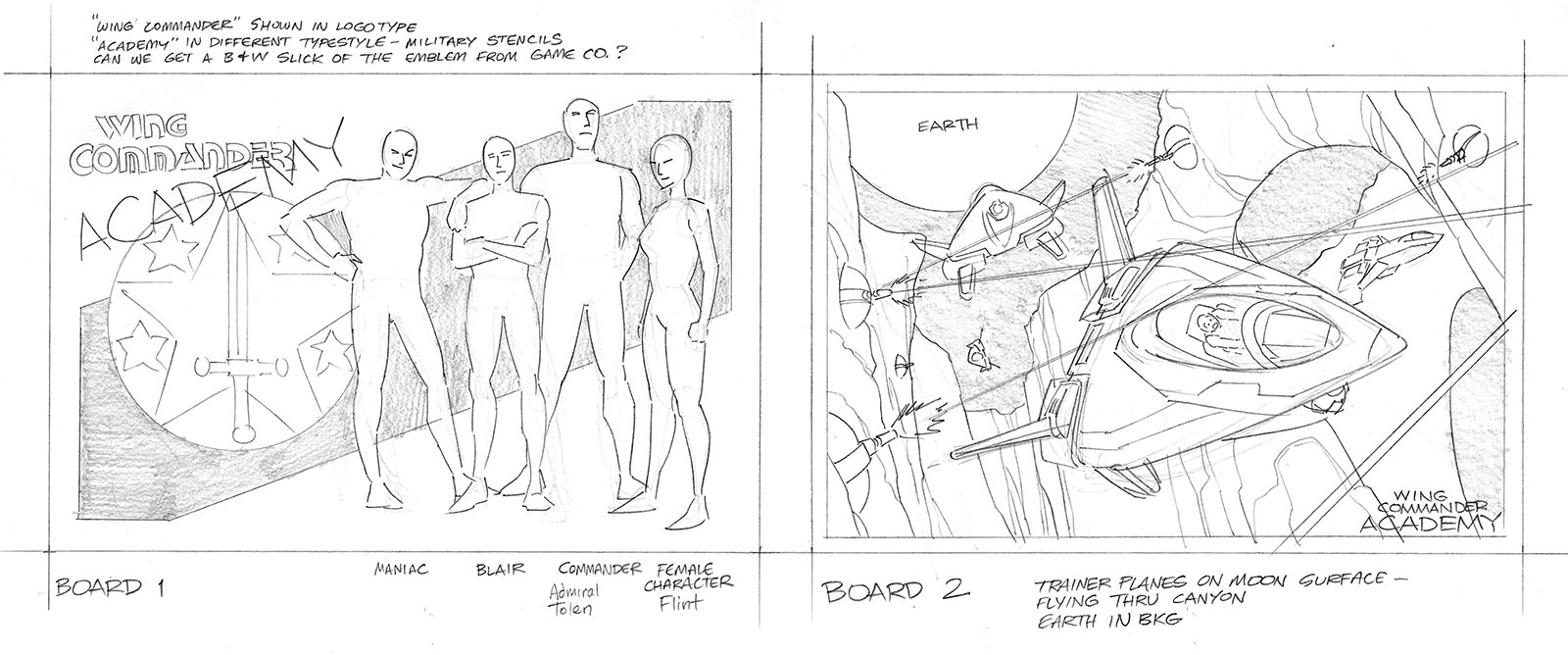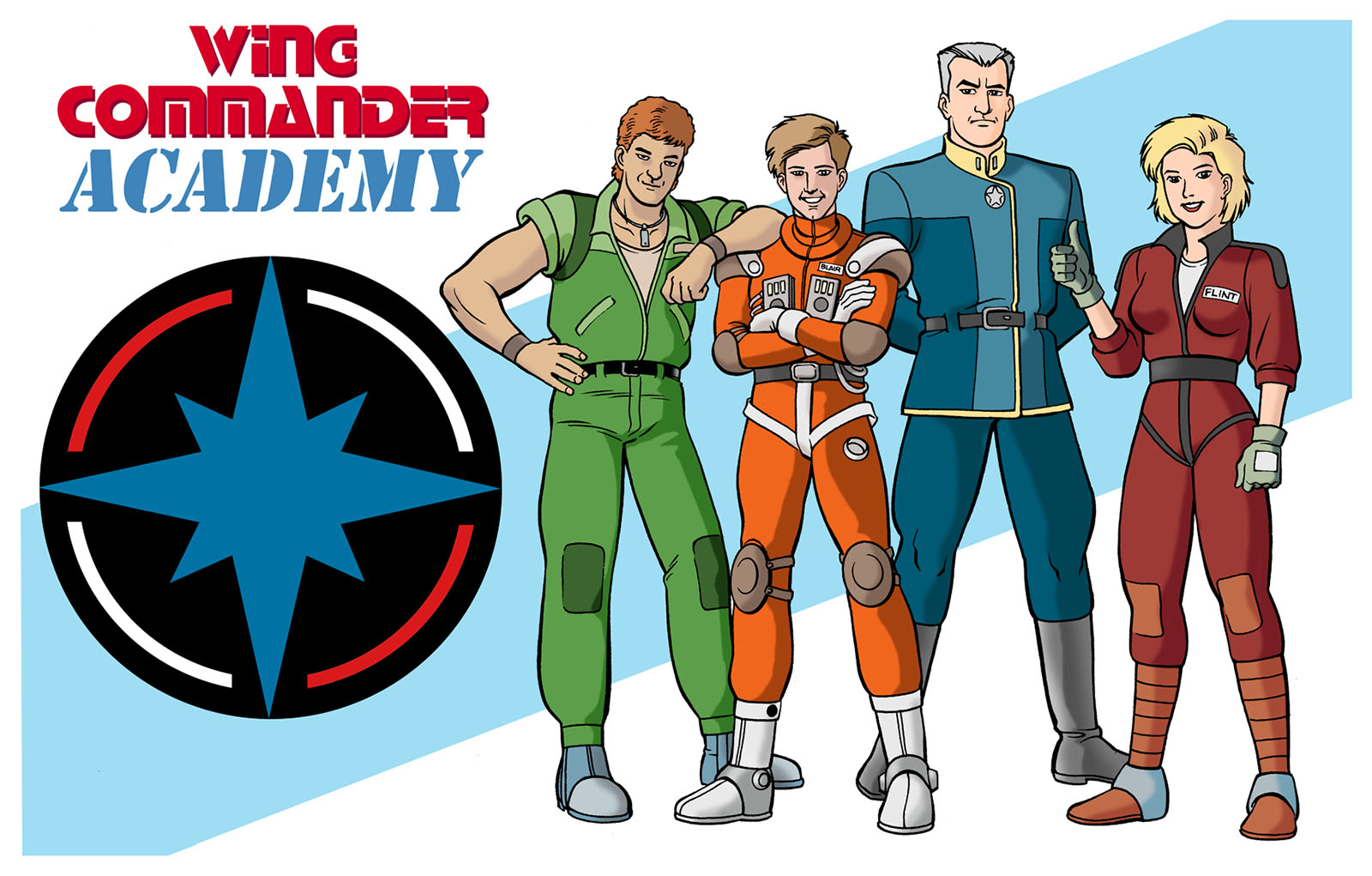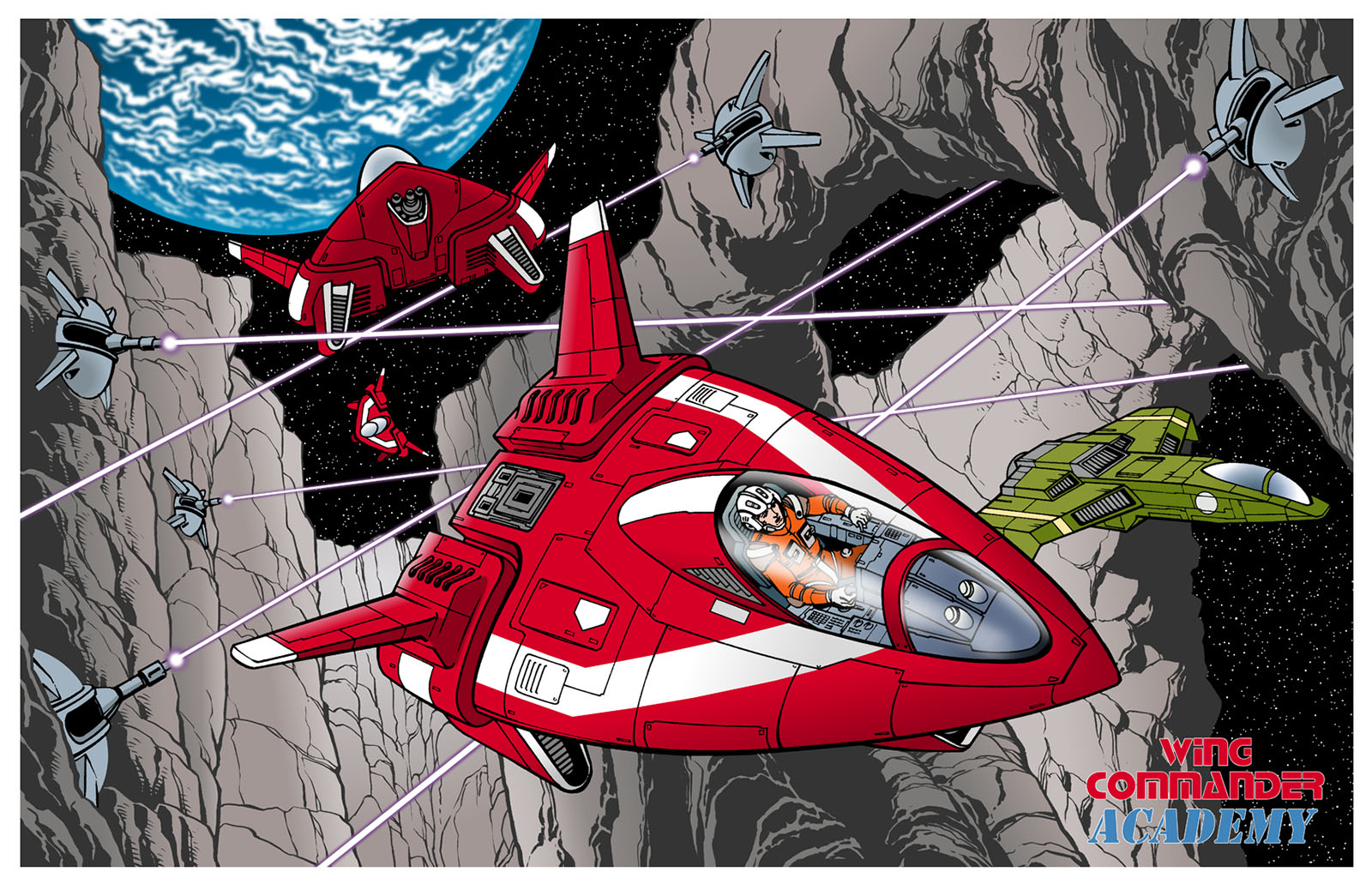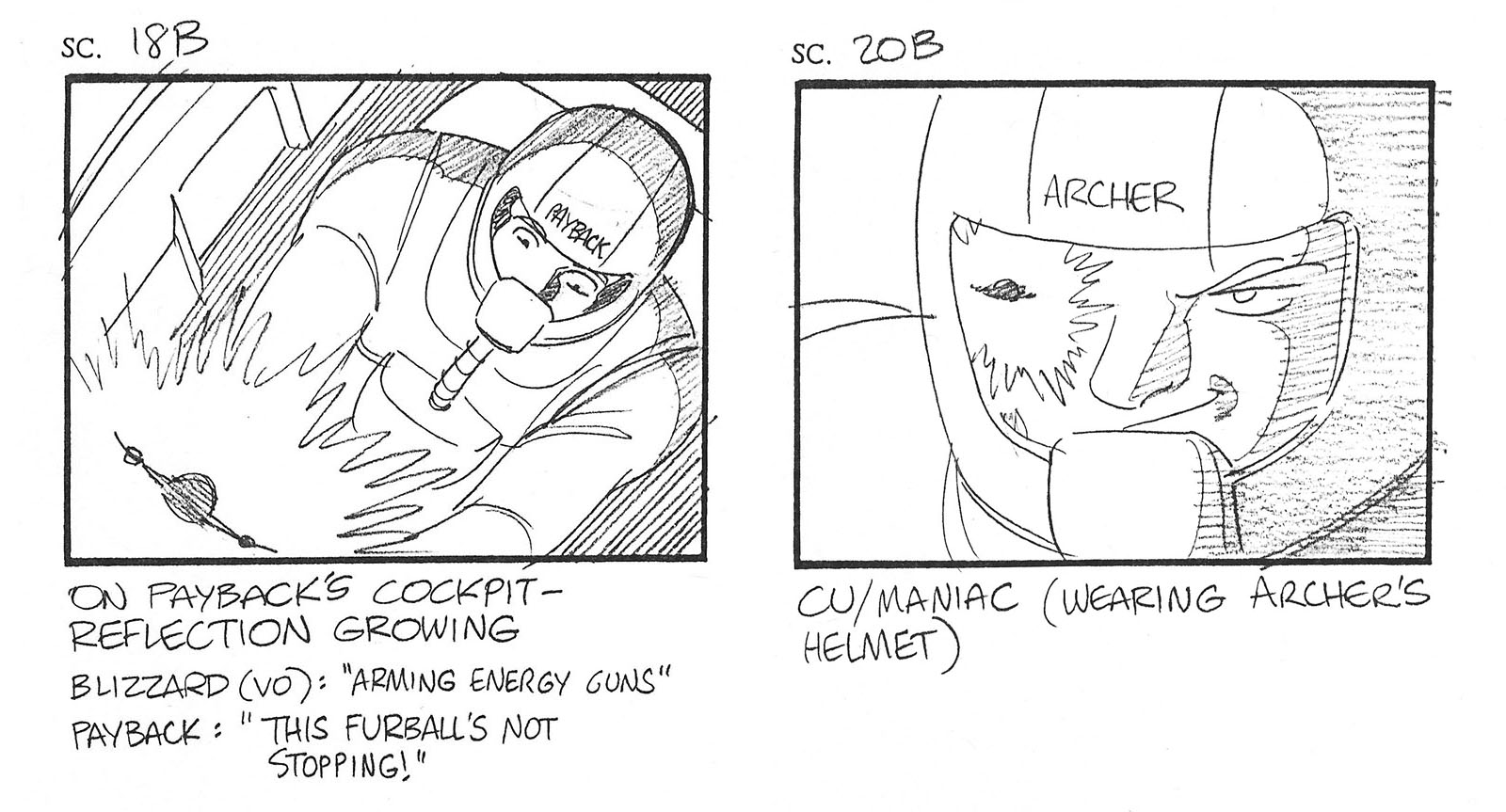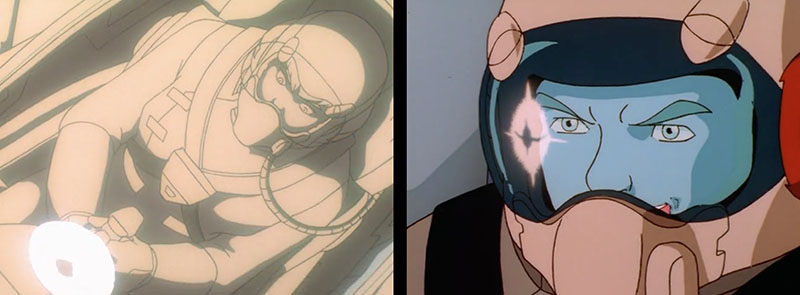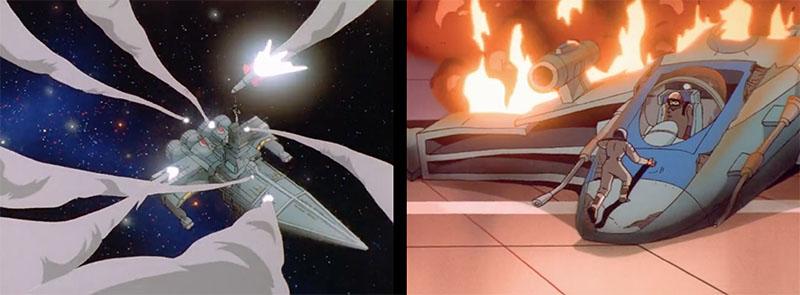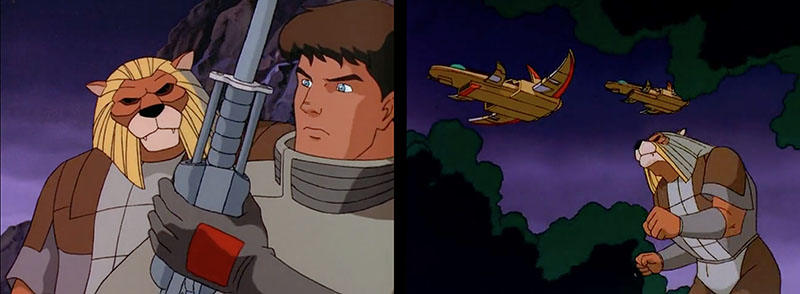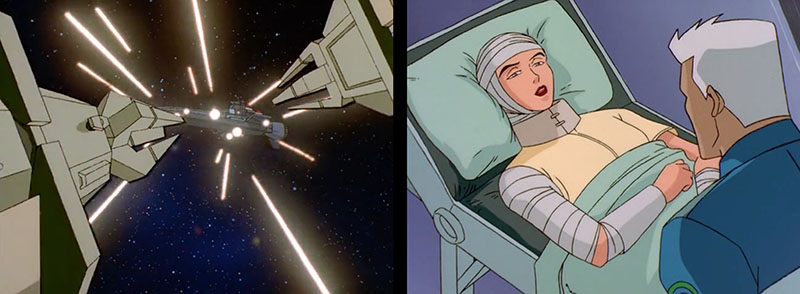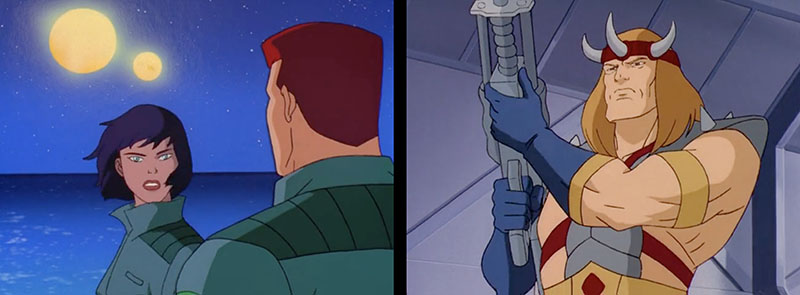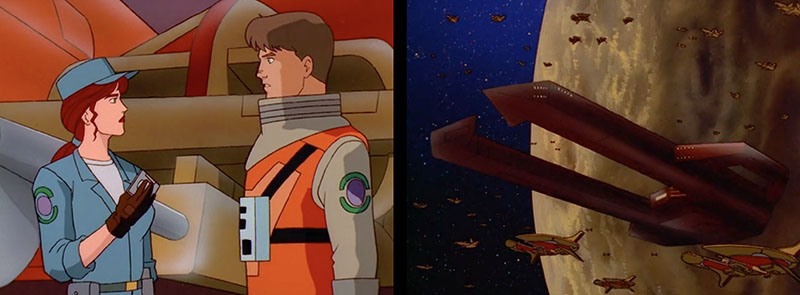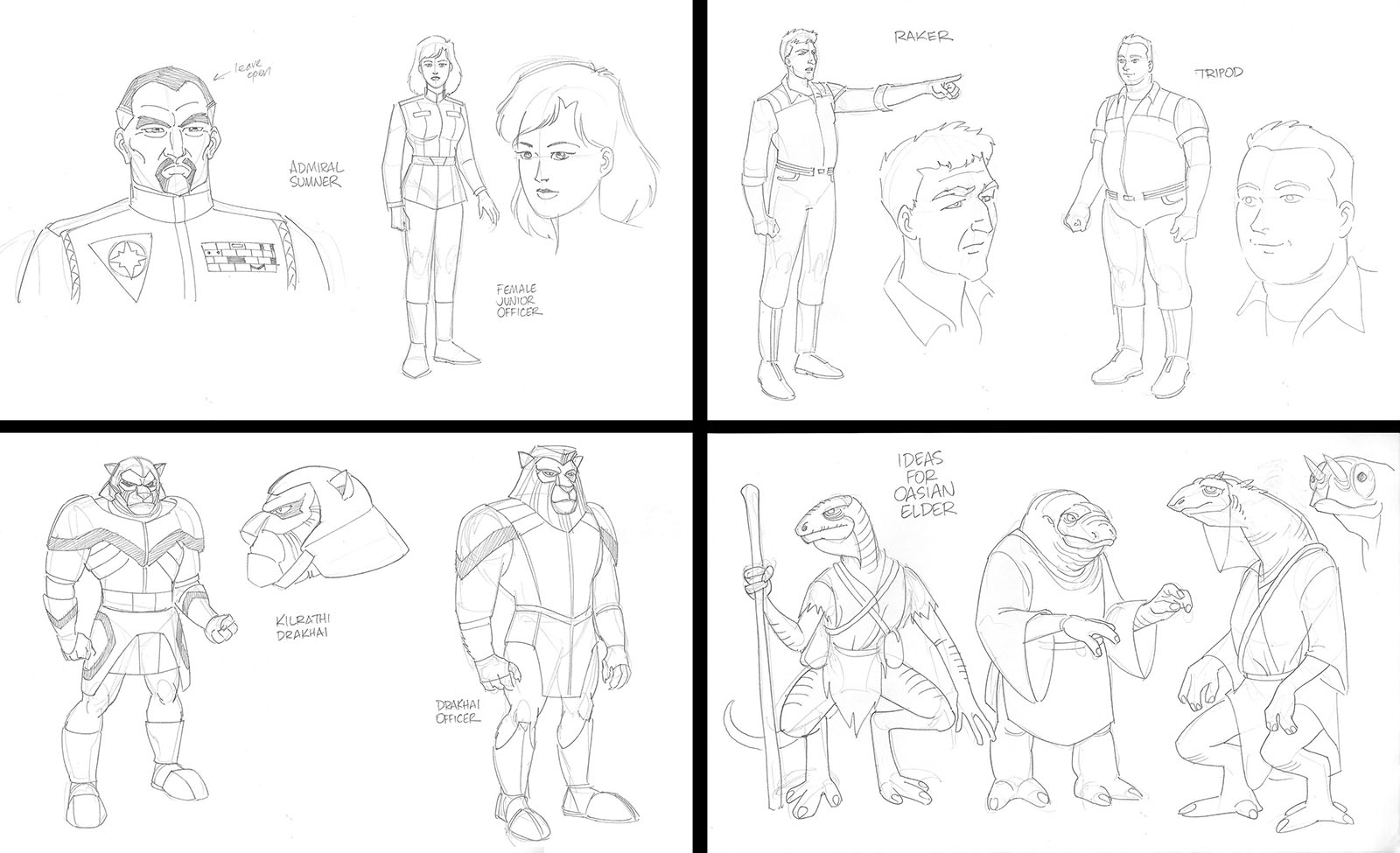Wing Commander Academy, 1996
What single decision did you make that changed your whole life?
For me, it was the decision to make Grease Monkey back in 1992. Everything I am now, everything I have now, started with that decision. I go into it in detail over at the Grease Monkey website here, so I’ll give you the short version.
One of the publishers that took it on was Kitchen Sink Press. They’d had some success turning their magnificent Xenozoic Tales comics into a TV cartoon called Cadillacs and Dinosaurs, and they were looking for another title to do the same. This was right around the time I approached them, so that was lucky timing. They published the comic and hooked me up with an agency (The Gotham Group) that represented animators to take the next step. I was paired up with a writer named Jymn Magon, and we developed a TV pitch that we took to various studios in 1995.
It’s a common Hollywood story for someone to get turned down by every studio until they get to the last one on the list and something magic happens. That’s how it went for me. The last studio on our list was Universal. When Producer Ralph Sanchez got a look at my Grease Monkey pitch, he told me about another show he was developing called Wing Commander Academy. In my pitch he saw what his show needed – presentation art to close the deal. He hired me on the spot as a freelancer to create two images from scratch (both shown below), and they got the job done. The next thing I heard was that the series was a go, and they wanted me on board.
Ralph shepherded Grease Monkey through a development deal at another studio the following year (Film Roman), but that was ultimately unsuccessful. The point of this story is that Grease Monkey qualified me for my first animation job, and I’ve been working in animation ever since. Whether or not Grease Monkey ever gets animated, the decision to make it changed my life.
So let’s talk about the first TV cartoon I ever worked on: Wing Commander Academy.
The Wing Commander franchise began with a 1990 computer game that took flight simulators into outer space, pitting the human race against a feline species called the Kilrathi. The first game spawned several more, and with the third game (1994) it had leveled up enough to attract major actors for live-action cutscenes, including Mark Hamill and Malcolm McDowell. This further boosted the game’s clout and ultimately brought it into consideration for a TV series. I can in no way take credit for anything that went on before I arrived, but I’m honored to have played an important part in getting it over the last hurdle.
I was certainly well-rewarded for my contribution. I’d been wanting to find a way into animation since I landed in L.A. three years earlier. Many artists before me had either graduated from comics to cartoons or drifted back and forth between them, so there was definitely a pathway. That pathway is a little different for everyone, but luck and timing are always critical ingredients. Right place, right time. Wing Commander Academy needed storyboard artists and a secondary character designer, and I was asked to be both; an incredible offer for someone with no prior experience.
I’d dabbled a little with storyboarding before then, but I didn’t know enough about filmmaking for it to give me an advantage. What I lacked in experience I made up for with what Ralph Sanchez must have recognized as aptitude. I’d been drawing comics non-stop for seven years by that point, refining my storytelling sensibility and designing whatever was needed on the fly. All those skills were transferrable.
Storyboarding came first. In the spring of ’96 I met the Supervising Director Larry Latham, who introduced me to all the elements of the show and presented me with my first assignment: Act 1 of Episode 3 (of 13). I’d never seen a TV script before, but it looked basically like every comic book script I’d ever worked with. I was given a big stack of storyboard paper to draw on, three panels per page. I just thought of them as comic book panels that didn’t change in size. Instead of a montage of images on a page, you’d just see one at a time on a TV screen. That actually made things easier, since I didn’t have to arrange panels to direct the flow and I didn’t have to deal with word balloons.
Therefore, I made the assumption that I could get through the initial rough pass for Act 1 in about three days. I’d been given two weeks, which seemed excessive, so I got other work done during the first week. I got a call from Larry at the beginning of week 2 to see how I was doing and I said that I would be starting the rough soon. It was due at the end of the week, and I didn’t see any problem with meeting that deadline.
The time came to start and I rolled through it pretty much as expected. The scenes came to me one by one according to the script and I drew what I assumed to be the necessary pictures to capture the action. Characters interacted, an alarm went off, fighters launched into space, and a dogfight began. It could have been a chapter of Grease Monkey with those beats, so I felt right at home. On Thursday I finished, photocopied the lot, and Fedex’d them to Larry at Universal.
On Friday, I got one of the most amazing phone calls of my life.
It was Larry, and he was utterly astonished. He said that after our call on Monday, he’d yelled at Ralph and yelled at my agent and was one inch from firing me. “This is week two and the guy hasn’t even started yet??? He doesn’t know what he’s doing!!! How could you hire somebody with no experience???” In response, they said to just remain calm and see what Tim could do. If he screws it up, drop him.
Remember, Larry is now telling me this on Friday.
He said that getting the whole thing done in three days was an absolute miracle. He’d never seen it before. Even if the board was full of problems – which it wasn’t – that achievement alone was enough to keep me on for the foreseeable future. He would have revisions for me, which I certainly expected as a newbie, but none of them were structural. In other words, my storytelling sense was right where it needed to be. The revisions would mostly be technical in nature, ways of making the animation easier or giving a scene additional impact.
Now I had two weeks to draw the finished board and incorporate Larry’s revision notes. Everything made sense and came together without fuss. My second assignment came right on the heels of this one, Act 2 of the same episode. Knowing what I know now, that probably meant that they gave me Act 1 early; most likely so that if I screwed it up they would have time to replace me and start over without knocking the episode off schedule. Since I didn’t screw it up, this episode would now be ahead of schedule. Always a nice bonus for everyone involved.
Act 2 went just as smoothly as Act 1. Even moreso, since I now had a little experience to fall back on and could avoid pitfalls. I found that timing was a new tool I could play with, which worked differently than in a comic book. With more pictures at my disposal, I didn’t have to compress quite as much. I could create more tension by building micro-moments on top of each other to reach a payoff. You can do that with comics, but you always have to rely on the reader to complete the formula. I had much more control over it in a storyboard, and I made the most of it in the combat scenes.
In particular, there was an enemy fighter that kept flying directly at our hero fighters in a game of chicken. I found the right combination of shots to build and build and BUILD that tension until someone chickened out. I could feel it happening intuitively, and it was exhilarating. When I eventually saw the finished episode, it exactly matched what I was going for. There was never a moment where I sat down with Larry and told him what I’d intended. The storyboards did the talking. Which is exactly what they’re supposed to do.
Over the course of the series, I contributed to five episodes with a total of six assignments. Character design work wove in and out as needed. Occasionally I got to draw my own designs in a storyboard, but for the most part I was designing characters for shows that I didn’t work on.
There was a point in the summer when I was called in-house to draw character designs all day long for a couple weeks, so that I could work directly with Larry. Just when I thought I’d finished everything on the list, along came another list. Just about everything sailed through without much revision. Either I gave them exactly what they wanted, or they just didn’t have time to nitpick it. Hopefully the former.
The series made its debut on USA Network in September 1996 and ran straight through December without a break, which is something that doesn’t happen any more. These days, at least on broadcast or cable, you see four or five episodes at a time and then they repeat for a bit until some new ones trickle out. If you put out a whole season without a break, people tune out when it restarts and your ratings drop through the floor. Back then, for whatever reason, the 13 episodes went non-stop for 13 weeks. I’m not sure what happened after that.
When I sat down to watch Episode 3 (on a Saturday morning), it was a revelation to see my work on TV for the first time. In addition to what I mentioned earlier, this was also a case where some characters I designed were moving through scenes I created. It looked like I had somehow drawn every frame of this Saturday morning cartoon. I was also surprised to see that some of my shots were chosen for the opening title, which I took as a huge compliment. The unexpected magic that played out at the beginning of this process resulted in unexpected magic at the end. I was elated. This was going to be my career.
An interesting side note, which I didn’t realize until I saw the end credits, was that a very prominent Japanese studio called Madhouse handled the animation for the series. They’ve been around since 1972 and have generated some very high-profile anime (which is listed on their Wikipedia page). It was actually the second time my career accidentally bumped into their work; one of my first comic book jobs was an adaptation of the Lensman anime, which Madhouse produced in the mid 80s.
Preproduction work on WCA wrapped in the summer of ’96. I was still a client for The Gotham Group, but they couldn’t do much for me since storyboard production typically ebbed in the fall. New shows wouldn’t start up until the next spring when networks had ratings to base decisions on. So I returned to full-time comic booking. It was a busy year with a lot of projects that I really miss, like adaptations of my two favorite anime shows, Star Blazers and Armored Trooper Votoms. I also turned in my last Star Wars project for West End Games. But the comic book biz was definitely fading and I really needed to make a jump.
As it happened, there was a studio that mainly worked for a syndicator. Syndicated shows could come and go at any time of year, and weren’t locked into seasonal production patterns. That studio was Sony Animation, and their next show went into hiring mode in early December. It would take me into a whole new world where ghosts needed busting.
Wing Commander Academy was eventually released on DVD in 2012 and began streaming on Peacock July 2020. You can also see all the episodes online for free right here!
Fair warning: the sound mix was all over the place, so in some episodes you can barely hear the characters over the music. Sound was not my department.
LINKS
MY STORYBOARDS
These are listed by production order. Broadcast order was slightly different, but there was very little specific continuity. See the links above for tips on viewing order.
Episode 3: The Most Delicate Instrument
Looking back on my first storyboard 25 years later (gasp), I can certainly see the lack of practical experience. There were a lot of revisions in the finished show, mostly to reduce scene count and clarify staging. My comic book background actually worked against me in a way I didn’t understand at the time; when I started drawing on a 3-panel storyboard page, I subconsciously treated it like a comic book and drew things at the right viewing size for that piece of paper. I didn’t have the knack for gauging them to the TV screen represented by the individual panels. The result was that most of my scenes were too tight; the camera was way too close to the subjects.
I also made some typical beginner mistakes like not realizing when I’d flipped the action to go in the wrong direction, drawing too few panels to indicate motion, and drawing kinetic effects (like those in a comic book) that wouldn’t actually be animated. You can see how all these things were revised or eliminated by comparing them to the finished episode.
You’ll also notice differences in how some props and costumes are drawn in the storyboard, like the pilots’ helmets. This was because a final model pack wasn’t ready yet, so I had to draw placeholders. On the upside, the space action was right on the money all the way through. I would draw it pretty much the same way today.
Click here for the Act 1 storyboard
Click here for the Act 2 storyboard
Episode 5: Word of Honor
My second episode was quite different from the first, an even mix of fighter action and ground pounding. Both require strategic choreography in 3-D space, but human characters offer a far greater range of interactivity than machines. The range is so great, in fact, that once you start down the path of interpreting it visually you’ll be on that path for the rest of your life. There is no end point.
Once again, I was drawing things too large in the frame, so unless the director issued a blanket directive to the animators, some poor cleanup artist probably had their hands full photocopying everything smaller and then filling in the margins. (I really hope they didn’t have to.) On the other hand, very little was changed on its way to the TV screen. That’s always a badge of honor, and especially gratifying for a beginner.
Click here for the Act 3 storyboard
Episode 7: Chain of Command
Other than the continuing problem of the camera still being too tight on the subjects, this board was darn near perfect. Almost no revisions in the finished show. Just a couple nips and tucks for length. I channeled a lot of anime for the space battles, so that probably helped. There were some ambitious scenes that paid off well, but the opening shot of the Tiger’s Claw rotating past the camera wasn’t one of them. Animating that kind of move by hand is extremely difficult. Today it would absolutely be done in CG.
Click here for the Act 3 storyboard
Episode 9: Recreation
This episode was a real oddball, part of a loosely-configured crossover with other Universal cartoons in its broadcast block. None of the main characters actually met, but an immortal soldier called the Warrior King passed through the different shows on his own timeline. An interesting experiment, but I have no idea if it resulted in crossover viewers.
I did the middle act of this show. Middle acts typically have the least amount of action, since it’s where the plot gets most of its development and this tends to focus on characters rather than dogfights. I enjoyed working on it for that reason, since it gave me a chance to exercise some different storytelling muscles. I especially liked the symbolism when a character who is questioning her life choices steps into gently lapping waves on a seashore. I don’t remember if that was my idea or if it was scripted that way, but the symbolism worked beautifully.
Once again, my board made it to the screen practically untouched. Great progress!
Click here for the Act 2 storyboard
Episode 13: The Glory of Sivar
Final episodes of a series are always a mixed blessing. It’s a relief to hit the finish line, but it’s a letdown to watch a crew peel off and go their separate ways just after they’ve mastered the style of a show. If a series gets renewed these days, it usually happens early enough to keep everyone working. But back in the 90s, broadcast schedules didn’t allow for it. By the time a second season got going, your old crew would likely be employed elsewhere and you’d have to start all over. Wing Commendar Academy didn’t get a second season, though it was a prequel to the video games so it didn’t particularly need one.
On the upside, when animators take on a final episode they often do some of their best work because they no longer have to reserve their energies for a next one. That’s what happened here, making for some of the best-looking animation of the whole season. I did the first act of the episode, and my board got a few more revisions than previous ones, but no matter. My first screen credits were on my resume and it wouldn’t be long before I got to add more.
Click here for the Act 1 storyboard


